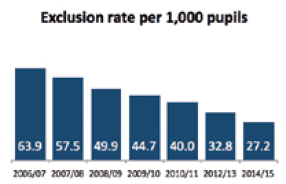National Improvement Framework for Scottish Education - 2016 Evidence Report
An overview of what we know about Scottish education and the context in which our children and young people learn.
Key Driver: School improvement
Each year, Her Majesty's ( HM) Inspectors inspect the quality of education in a sample of schools. These inspections cover primary, secondary, all-through and special schools. They aim to provide assurance on the quality of Scottish education and promote improvement in schools. Inspection reports for individual schools and more information about school inspections can be found on the Education Scotland inspection and review pages.
Below is a summary of main findings on school improvement from school inspections. This information includes inspections of publicly funded and grant aided schools. It does not include inspections undertaken by Education Scotland of independent schools and independent special schools.
One of the aspects which HM Inspectors evaluate in school reports is the overall performance of their pupils' progress, and how well the school does in improving this.
62% Between April 2015 and March 2016, 129 schools were inspected, of which quality indicators were evaluated for 114 schools. 62% of them were evaluated as good., very good or excellent on ‘improvements in performance’ (and 91% as satisfactory or better). However, note this is not representative of all Scottish schools.
HM Inspectors also evaluate schools’ ability to undertake self-evaluation in order to improve the quality of learning and teaching.
55% Of the 114 schools inspected, where quality indicators were evaluated, between April 2015 and March 2016, 55% were evaluated as good, very good or excellent on ‘improvement through self-evaluation’ (85% as satisfactory or better). Again, this is not representative of all Scottish schools.
HM Inspectors also inspect early learning and childcare settings. This includes local authority settings and private, independent and voluntary pre-school settings which are in partnership with local authorities to provide pre-school education for children. Between April 2015 and March 2016, 135 pre-school centres were inspected, of which quality indicators were evaluated for 131 centres.
Of the 131 early learning and childcare settings inspected between April 2015 and March 2016:
74% were evaluated as good, very good or excellent on ‘improvements in performance’ (and 95% as satisfactory or better). However, note this is not representative of all early learning and children settings in Scotland.
58% were evaluated as good, very good or excellent on ‘improvement through self-evaluation’ (89% as satisfactory or better) Again, this is not representative of all Scottish early learning and childcare settings.
Attendance, absence and exclusions
Information on attendance, absence and exclusions from
school is now collected on a biennial basis, with the most recent
data for the 2014/15 academic year published in
Summary
Statistics for Schools in Scotland.
93% was the total attendance rate recorded for 2014/15. This is an increase from 93.2% fir 2007/08. The attendance rate was higher for primary schools ( 95.1%) than secondary schools ( 91.8%) and specials schools ( 90.7%).
Pupils living in areas with higher levels of deprivation had lower attendance rates. In secondary schools, pupils living in the 20% most deprived areas had an attendance rate that was 5.8 percentage points lower than the pupils living in the 20% least deprived areas.

The exclusion rate for all pupils in 2014/15 was 27.2 per 1,000 pupils. This has been falling year on year since 2006/07.
Rates of exclusions per 1,000 pupils for pupils living in the 20% most deprived areas were 52 per 1,000 pupils compared with 7.9 per 1,000 pupils living in the 20% least deprived areas.
The latest PISA 2015 Scotland report shows that:
Scottish students were more likely than OECD students to say that they had 'Never' skipped classes in the two weeks prior to the PISA test ( 80.3% compared with 73.9%) and less likely to report that they had done this 'Once or twice', 'Three or four times' or 'Five or more times'.
However, they were less likely to report that they had 'Never' arrived late for school in the two weeks prior to the assessment ( 53.1% compared with 55.5%) and similar to the OECD in the other categories.
Scottish students were more likely than the OECD to be in schools were the headteacher said that 'Student truancy' hindered learning 'Very little' ( 66.3% compared with 51.9%) and they were less likely to be in schools where the headteacher reported this to be true 'To some extent' or 'A lot'. This pattern was also true for 'Students skipping classes'.
Contact
There is a problem
Thanks for your feedback